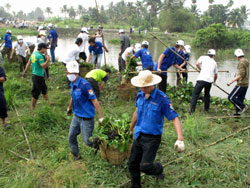 The coliform bacteria in the rivers has exceeded permitted levels, according to research results released at a meeting of the city's Department of Natural Resources and Environment last week.
The coliform bacteria in the rivers has exceeded permitted levels, according to research results released at a meeting of the city's Department of Natural Resources and Environment last week.
The water-quality tests at 11 of 16 water-observation stations do not meet standard levels.
Besides wastewater from industrial production, other pollutants come from sewage systems and garbage dumps as well as mining, farming and husbandry activities.
Water leakage from household-septic tanks and illegally discharged household waste-water are also polluting the rivers.
About 80 per cent of the city's households use septic tanks, with water leakage from the tanks polluting nearly half of the of the city's underground water volume.
Experts have recommended that the city build a new urban sewage system and underground-water observation system.
Nguyen Van Phuoc, deputy head of the department, said several measures would be carried out to protect water quality of the Sai Gon and Dong Nai rivers.
The department is working with the provinces of Tay Ninh, Binh Duong, Dong Nai and Ba Ria-Vung Tau to conduct a survey of companies' waste water discharge that is illegally released into the two rivers, both of which supply water for the city.
Based on the data, violators would be fined or penalised.
The department had also completed inspection of companies that had released more than 50cu.m of waste water into the Sai Gon River, Phuoc said.
Of the 450 inspected companies, 269 companies do not have a waste water treatment system.
The department had also asked the affected provinces to divide the river into zones to receive wastewater.
Under the measure, companies that cause pollution will not be allowed to operate on the river's upper stream areas or in areas that are sources of tap water.

Leave your comment on this story